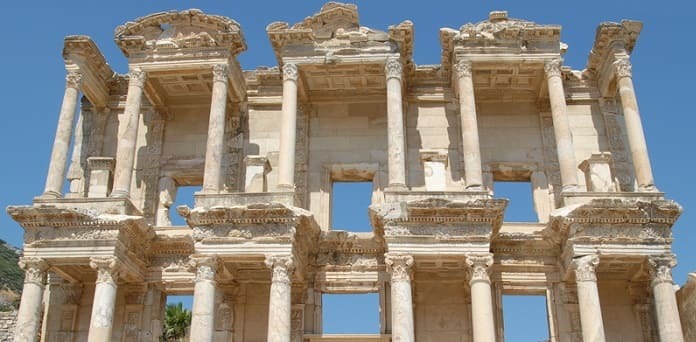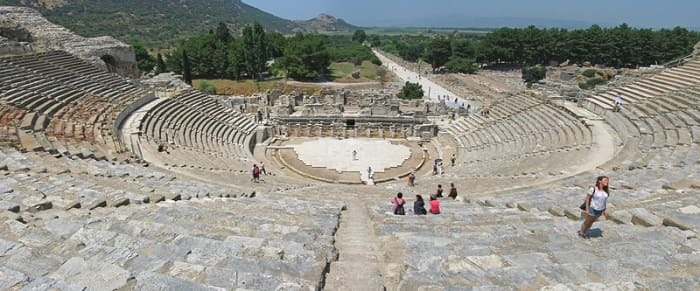

Asia Minor is located in Westen Asia and covers most of the present day Turkey. This region has a rich and diverse history, with human settlements dating back to the Palaeolithic era. Throughout the centuries, various civilizations and cultures developed in Anatolia, leaving behind a rich cultural heritage.

Celsus Library, in Ephesus, Asia Minor, Turkey
Description: The library of Celsus Library in Ephesus Asia Minor Anatolia now Turkey
Asia Minor is a historical term that refers to the westernmost part of Asia, which is now mostly located in modern-day Turkey. The regions of Asia Minor include Anatolia, which is the most populous and economically developed region of Turkey, and the Eastern Anatolia Region, which is known for its rugged terrain and mountainous landscapes.
Other regions in Asia Minor include the Marmara Region, which is known for its industrial and commercial centres, and the Aegean Region, which is known for its beaches, ports, and tourist destinations.

Ancient theatre in Ephesus, Asia Minor, Turkey
Description: Ancient theatre in Ephesus, Asia Minor, Turkey, the capability of 25000 seats, panoramic view
There are many famous sites and people associated with Asia Minor. Some of the most notable include −
The ancient city of Troy − Located in northwest Anatolia, was made famous by the Trojan War described in Homer's Iliad.
Ephesus − An ancient Greek city located on the west coast of Asia Minor that is known for its well-preserved ruins, including the Temple of Artemis, one of the Seven Wonders of the Ancient World.
The Hittite Empire − An ancient empire that existed in Asia Minor from the 18th to the 12th century BCE, known for its powerful military and sophisticated legal and political systems.
Saint Paul − The Christian apostle who spent many years in Asia Minor, establishing early Christian communities and spreading the teachings of Jesus Christ.
The Byzantine Empire − The eastern half of the Roman Empire that continued to thrive in Asia Minor after the fall of Rome, and was known for its culture, art, and architecture
Asia Minor has a rich mythology and history that spans several millennia. Some key aspects of its mythology and history include −
According to Homer's Iliad, the Trojan War was a 10-year siege of the city of Troy by a coalition of Greek forces, ultimately resulting in the city's destruction. The war was sparked by the abduction of Helen, the wife of the Greek king Menelaus, by Paris, a prince of Troy.
The Hittites, who dominated Asia Minor from the 18th to the 12th century BCE, had a complex mythology that included gods and goddesses such as Teshub, the god of thunder, and the sun goddess Arinniti. Many of their myths were passed down through a collection of cuneiform texts known as the Hittite myths.
The Byzantine Empire was the eastern half of the Roman Empire that continued to thrive in Asia Minor after the fall of Rome. It was known for its culture, art, and architecture, and it played a major role in shaping the history of the region.
The Ottoman Empire was a powerful state that dominated Asia Minor and much of southeastern Europe from the 14th to the early 20th century. It was known for its military conquests, its sophisticated legal and political systems, and its rich cultural heritage.
The Kemalist revolution in Turkey, led by Mustafa Kemal Atatürk in the 1920s, brought significant political and social changes to the region, modernizing and secularizing the country. The Republic of Turkey was established as a result of this revolution.
During the prehistoric period, various civilizations and cultures developed in Anatolia, including the Hittites, Assyrians, and Persians. The region also served as a crossroads for trade and cultural exchange between Europe and Asia.
The Hittites, who emerged around 1600 BCE, established an empire that controlled much of Anatolia and parts of the Near East. The Phrygians, who arrived in the region around 1200 BCE, established a powerful kingdom centred in Central Anatolia. The Lydians, who rose to power in the 7th century BCE, were known for their wealth and were the first society to mint coins. The Persians also controlled the region for a time, and Alexander the Great conquered Anatolia in the 4th century BCE as part of his campaign to conquer the Persian Empire.
Classical Anatolia refers to the period of ancient history when the region was dominated by Greek city-states and later the Roman Empire. In the 8th century BCE, Greek colonies began to be established along the coast of Anatolia, particularly in Ionia (the western coast of modern-day Turkey). These colonies, known as the Ionian cities, developed a unique culture that combined elements of Greek and Anatolian traditions. They also played an important role in the spread of Greek culture throughout the region.
In conclusion, Asia Minor, or Anatolia, is a region with a rich history and cultural heritage. Its strategic location at the crossroads of Europe and Asia has made it a melting pot of cultures and civilizations throughout history. The discovery of many significant archaeological sites in Anatolia, such as Çatalhöyük and Gobekli Tepe, has provided valuable insights into the lives of prehistoric peoples in the region, and the legacy of the classical period can still be seen in many of the impressive ruins and monuments that dot the landscape today.
Q1. What are some of the major cities in Asia Minor?
Ans. Some of the major cities in Asia Minor include Istanbul (formerly Constantinople), Ankara, Izmir (formerly Smyrna), Adana, Antalya, and Bursa. These cities are known for their rich history, cultural significance, and modern amenities.
Q2. What are some of the cultural traditions and cuisines of Asia Minor?
Ans. Asia Minor is home to a diverse range of cultural traditions and cuisines, reflecting the region's long history and the many cultures that have influenced it over the centuries. Some of the most notable cultural traditions include Turkish music and dance, the Whirling Dervishes, and traditional handicrafts such as rug weaving and ceramics. Turkish cuisine is also renowned for its rich flavors and variety, with dishes such as kebabs, meze, and baklava being popular throughout the world.
Q3. What was the significance of Asia Minor in ancient times?
Ans. Asia Minor had a strategic location at the crossroads of Europe and Asia, making it a melting pot of cultures and civilizations throughout history. It was also an important centre of trade and culture in the ancient world.